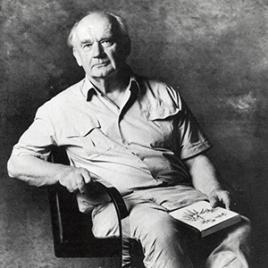
Sir Norman Robert Foster, Baron Foster of Thames Bank, is a British architect and designer. Closely associated with the development of high-tech architecture, Foster is recognised as a key figure in British modernist architecture. His architectural practice Foster + Partners, first founded in 1967 as Foster Associates, is the largest in the United Kingdom, and maintains offices internationally. He is the president of the Norman Foster Foundation, created to 'promote interdisciplinary thinking and research to help new generations of architects, designers and urbanists to anticipate the future'. The foundation, which opened in June 2017, is based in Madrid and operates globally. Foster was awarded the Pritzker Prize in 1999.

Richard George Rogers, Baron Rogers of Riverside, was a British-Italian architect noted for his modernist and constructivist designs in high-tech architecture. He was a senior partner at Rogers Stirk Harbour + Partners, previously known as the Richard Rogers Partnership, until June 2020.
Peter Rice was an Irish structural engineer. Born in Dublin, he grew up in 52 Castle Road, Dundalk in County Louth, and spent his childhood between the town of Dundalk, and the villages of Gyles' Quay and Inniskeen. He was educated at Queen's University of Belfast where he received his primary degree, and spent a year at Imperial College London. Rice acted as Structural Engineer on three of the most important architectural works of the 20th century: the Sydney Opera House, Pompidou Centre and the Lloyd's Building and was renowned for his innate ability to act as both engineer and designer.
The year 1999 in architecture involved some significant architectural events and new buildings.
The year 1994 in architecture involved some significant architectural events and new buildings.

Gillespie, Kidd & Coia was a Scottish architectural firm famous for their application of modernism in churches and universities, as well as at St Peter's Seminary in Cardross. Though founded in 1927, they are best known for their work in the post-war period. The firm was wound up in 1987.
Arup is a British multinational professional services firm headquartered in London that provides design, engineering, architecture, planning, and advisory services across every aspect of the built environment. It employs about 17,000 people in over 90 offices across 35 countries, and has participated in projects in over 160 countries.

Roderick George Robbie was a British-born Canadian architect and planner. He was known for his design of the Canadian Pavilion at Expo 67 and Toronto's Rogers Centre (SkyDome).

RSHP is a British architectural firm, founded in 1977 and previously known as the Richard Rogers Partnership which became Rogers Stirk Harbour + Partners in 2007. The firm rebranded from Rogers Stirk Harbour + Partners to simply RSHP on 30 June 2022, after the retirement and death of Richard Rogers. Its main offices are located in the Leadenhall Building, London, completed to the firm's designs in 2014. Previously they were at the Thames Wharf Studios. In its various incarnations it has designed many important buildings including the Lloyd's building and the Millennium Dome in London and the Senedd building in Cardiff.
Anthony James Hunt, familiarly known as Tony Hunt, was a British structural engineer of numerous world-renowned buildings, with a career spanning from the 1950s until his retirement in 2002. As a leading proponent of British High Tech architecture and with a strong interest in both engineering and industrial design, Hunt was a major player in creating the High Tech movement of Norman Foster and Richard Rogers. He formed Anthony Hunt Associates in 1962. He worked with Rogers and Foster on Reliance Controls building in Swindon (1966) which was the first building of the British High Tech architecture, or more generally the High Tech architecture style. He was also a structural engineer on the Waterloo International railway station in London (1993).
Angela Brady OBE is an Irish-born Irish/British architect and has lived in London for over 25 years. In 2011 she was elected president of the UK's Royal Institute of British Architects (RIBA) for a two-year term. She is a past chairperson of the Royal Institute of the Architects of Ireland (RIAI) London Forum.
Charles Jean Ménart was a Belgian architect who worked in Scotland in the early 20th century and specialised in designing Roman Catholic churches in the Baroque Revival style.

Sir Peter Faulkner Shepheard FRTPI FILA was a British architect and landscape architect.

Gabriel Epstein, often known as Gabi Epstein, was a British architect and urban planner, particularly noted for his master plan of the University of Lancaster, as well as several other major development plans and social housing plans.
Susan Jane Rogers is a British designer and educator. She was a co-founder and partner during the 1960s and 1970s in two architectural practices Team 4 and Richard + Su Rogers. From 1986 to 2011, she was a partner in Colquhoun, Miller and Partners. Rogers was a member of the team that won the design competition for the Pompidou Centre in the 1970s, and she co-designed the concept Zip-Up House in the 1960s. She was also responsible for two notable commissions from her parents: Creek Vean and Pillwood House, which are both Grade II* listed buildings.
British high-tech architecture is a form of high-tech architecture, also known as structural expressionism, a type of late modern architectural style that emerged in the 1970s, incorporating elements of high tech industry and technology into building design. High-tech architecture grew from the modernist style, using new advances in technology and building materials.

H. E. and A. Bown was an architectural practice in Harrogate, North Riding of Yorkshire, England, in the 19th and early 20th centuries. Its two partners were Henry Edwin Bown who started the business and died at the age of 36, and his brother Arthur Bown, who carried on the business until he retired in 1911.







